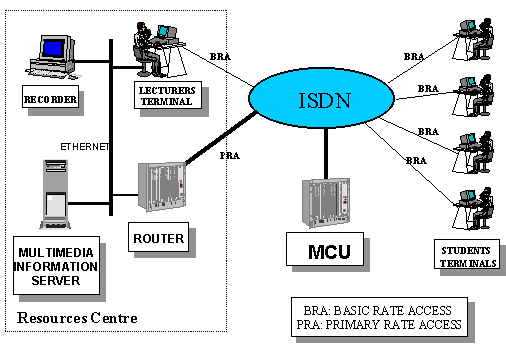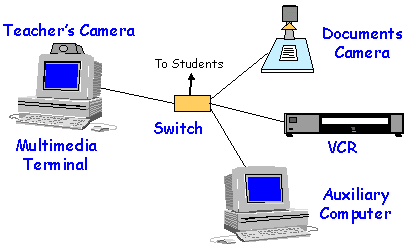
My teacher is on the network
(Experiences using multimedia
communication technologies in distance learning)
Encarna Pastor, David Fernández, Tomás Robles
Dept. Ingeniería de Sistemas Telemáticos
Universidad Politécnica de Madrid
ETSI Telecomunicación, Ciudad Universitaria,
E-28040 Madrid, Spain
Tel: (+34 1) 336 73 28 - Fax: (+34 1) 336 73 33
encarna@dit.upm.es, david@dit.upm.es,
robles@dit.upm.es
Abstract
The Teleeducación-RDSI project aims to evaluate the adequacy
of multimedia communication technologies applied to distance education.
For that purpose, graduate and postgraduate courses of the Telecommunication
Engineering Faculty were chosen to form the educational scenario for the
experimentation of a tele-education system based on mature technologies
like Internet, ISDN or H.320 videoconferencing. This paper tries to summarise
the experience gained during the project, presenting the technical aspects
and infrastructure used, the design of the educational experiences, as
well as the evaluation results.
1. Introduction
The use of communication technologies and telematics services in education offer a great potential that may contribute to the introduction of new educational paradigms and to enhance the learning process. Nevertheless, it is difficult to find experiences that permit to evaluate, in real conditions, the effects on learning, the limitations that may jeopardise it success, the cost factors that may limit its possible extension or, furthermore, their acceptance by teachers and students.
The Teleeducación-RDSI project, supported by CITAM (Centro de Investigación en Tecnologías y Aplicaciones Multimedia) a research center of the Technical University of Madrid (UPM), aimed to evaluate the adequacy of multimedia communication technologies applied to distance education. The project, recently finished, was not intended as a laboratory experience, but as a real educational experience whose results may enable its extension to a larger scale.
Graduate and postgraduate courses of the Telecommunication Engineering Faculty formed the educational scenario chosen for the experiences. Using video-conference and Internet tools over the public ISDN network, students of the University attended lectures from their homes in real time. They also had the facility to access the contents of the didactic material, interact with others students to work in teams or even contact directly with the teacher for tutoring. Four phases were defined to carry out the experiments, each one providing new technical functionalities and centred around different students/subjects profiles.
This paper summarises the experiences and main results gained in Teleeducación-RDSI
project. In the next sections, we focus on the technical aspects and infrastructure
used in the project, the design of the educational experiences and on the
evaluation results.
2. Technical Aspects and Infrastructure
From the technical point of view, the project aimed to evaluate the adequacy of mature multimedia communication technologies applied to distance education. By means of some pilot trials, we tried to gain enough experience to be able to create stable tele-education services using these technologies.
By mature technologies, we understood those technologies that were widely available in the market, and, supposedly, stable enough to let us focus on the educational part of the experiences. In particular, we decided to use:

Figure 1 shows the global architecture of the system that was set up for the experiences. It is composed of the following elements:

In addition, the auxiliary computer performs the recording of the lectures in real time. The students are able to access a lectures database (located in the multimedia server) to retrieve either a complete lecture or part of it.
Figures 4 and 5 shows two different views of lecture’s terminal.
3. Pilot Experiences
The Project was structured into four phases corresponding with four different experiences, where each one provided new technical functionalities and new student profiles. Such incremental strategy allowed each experience to benefit from the evaluation results of the previous one, as well as to give time to the developers to finish the specific developments without delaying the whole experience.
The number of students was around 10 in each phase, which offers a compromise between the convenience of having a number of students that allows the generalisation of results and the technical conditions and economical limitations of the project. The students were geographically distributed over the Madrid area.
Table 1 summarises the subject, audience and system functionality of
each phase of the project.
| Subject and Date | Audience | System Functionallity |
| Introduction to C++
(May 96) |
Postgraduate course for Telecommunication Engineers. |
|
| Introduction to Microsoft PowerPoint
(Nov 96) |
On-the-job training course for administrative staff of CITAM companies | 1st phase functionality plus:
|
| Spain in the Information Society
(May 97) |
Undergraduate course for Telecom. Engineers (first year) | 2nd phase functionality plus:
|
| Radiocommunications
(Dec 97) |
Undergraduate course for Telecom. Engineers (fifth year) | 3rd phase functionality plus:
|
4. Evaluation
Several aspects have been taken into account to carry out the evaluation of the experiences:
5. Conclusions and Recommendations
Globally speaking, the system reached a high degree of acceptance between students and teachers. Both of them think it is feasible to attend classes from home or office, although they see some problems due to social interruptions, either at home or at office.
They think the system saves time and travel costs and they find it more
suitable for short and optional courses, like the ones imparted in postgraduate
programs. For regular courses, they prefer the traditional education, mainly
because of the direct contact with other students.
The students appreciated more participation and individual treatment
during the experiences, due, of course, to the smaller number of students,
but also to the higher interactivity reached with the system.
In general, they had no special problems using the system. After a short introductory session to show how to use it, they were able to manage themselves without support. The case of the teachers was similar, although as we mention below, due to technical instabilities, a technician permanently assisted them.
From the educational point of view, it is important to adapt the didactic material to the system and try to use videos and complementary material, mainly to increase the interactivity and participation. It was found that the participation depends greatly on teachers' attitude, so they have to adopt an exposition-questions modality.
The cooperative applications were highly valued by the students. During the experiences, they made heavy use of them to prepare the exercises proposed by the teacher. However, due to the limitation of these applications to point to point interactions, it was not possible to create workgroups of more than two students.
About the course design, one conclusion is that to maintain the interactivity and create group spirit, the number of students should not be higher than 10. The classes should be given in alternate days in two hours modules, with a short break after the first hour. Besides, it was found necessary to have a Course Coordinator, that is, a person that will be the link between all the parts involved: the teacher, the students, the technicians, the evaluators, etc.
Related to economical aspects, it was found that the use of this system requires an additional effort by teachers, in order to adapt the materials to the peculiarities of this media. This increase in the effort is estimated around 30%, although it is much lower in case of practical or training courses (for example, the PowerPoint course in the second phase) than in theoretical ones.
The cost analysis led to the conclusion that the main cost incurred in the experiences is the one derived from the use of the MCU. The commercial tariffs of this service (~40 ECU per hour and port at that time) were so high that it results profitable to buy an MCU for the resources centre if it is going to be used frequently. The costs derived from the use of ISDN were not high, mainly due to the fact that most of the calls were metropolitan (not long-distance calls). Fortunately, in this project both costs (MCU and ISDN) were assumed by Telefónica, which was one of the project partners.
From the technological point of view, the main conclusion we can reach is that the "mature" technologies chosen for the project were not so stable as we thought at the beginning of the experience. During the different phases of the project we experimented several instabilities, mainly due to the videoconferencing hardware and software in student terminals. The installation and configuration of the equipment was costly in time and effort.
In general, the technology was not imposing a strong limit in the realisation of the educational goals, but the students and teachers pointed that some technical aspect should be improved in the future.
In particular, the quality of images transmitted during multipoint sessions was considered negatively. This fact was caused by the inability of the MCU and the shared applications to support standard T.120 data applications (in fact, the first products conforming to this standard were not available until the last phase of the project). During multipoint sessions, the only way to transmit images (slides, documents, etc) was through the video channel, which led to an appreciable loss of quality and obliged the teachers to use big fonts and consequently reduce the quantity of information in each slide. With the present availability of T.120 products, this fact would not be a problem anymore: the slides could be transmitted through a data channel using a shared application. Besides, the use of shared applications in multipoint sessions, not only in point to point configurations, was found very useful by the students to work in groups.
Another aspect evaluated negatively was the MCU voice switching mechanism. At any time, the MCU tries to switch to the video of the participant speaking louder. But, the students and the teachers considered that the switching time was too long to follow the interactivity of the classes. Besides, there were some other specific problems in the switching algorithm that contributed to distract the attention of students. For example, any time a new participant entered the session, the video was switched to him, distracting the rest of students from what the teacher was saying.
We also faced some ISDN interoperability problems. We discovered that
some of the students were not able to connect to the ISDN router to gain
Internet access. Further investigation of this problem lead us to discover
a subtle peculiarity in the videoconference card ISDN software that, depending
on the location of the student (and the ISDN switch model he was connected
to), made the connection fail.
Finally, although the system was designed to allow a teacher to use
it without needing permanent technical support during the classes, the
instabilities of the technology made necessary to have one person permanently
available.
6. References
| [1] | T. Robles, D. Fernández, E. Pastor and S. Alamillo. “Using Multimedia Communication Technologies in Distance Learning”. SIGCSE/SIGCUE Conference on Integrating Technology into Computer Science Education. Uppsala, Sweden, June 1997. |
| [2] | GATE. “Informes de Evaluación de las distintas experiencias”. Internal Deliverables of Teleeducación-RDSI project. 1996-97. |
| [3] | A. Hernández, D. Fernández, T. Robles, E. Pastor et al. “Proyecto de Teleeducación RDSI del CITAM: Sistema de Grabación y Reproducción de Clases”. Seventh Telecom I+D. Madrid, October 1997. |
| [4] | CITAM, http://www.etsit.upm.es/asociados/citam |
| [5] | Teleeducación-RDSI project. http://www.dit.upm.es/~robles/trdsi/trdsi.html |
Papers from the 1st LEVERAGE Conference |
LEVERAGE home page |